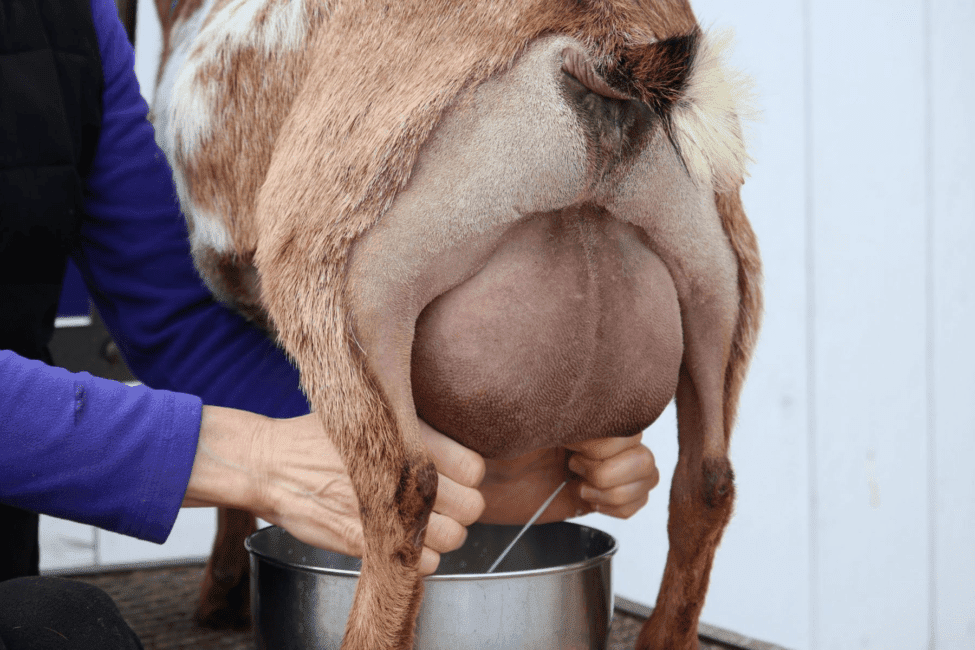Goats milk can be increased through carrying out the proper routine farm management practices in your farm, milk your goats every 12 hours on a regular schedule.
Ensure that the milking area is away from the dust of the housing and feed areas. Wash the udder and teats with warm water and an udder washing solution (available from farm stores), and dry thoroughly.
This promotes clean milk but just as importantly stimulates milk let-down. Milking might seem difficult at first, but most people get the hang of it after a little practice.

1. Close off the top of the teat with your thumb and forefinger so the milk in the teat will be forced out of the teat, not back into the udder.
2. Next, close your second finger, then the third, and finally your pinkie, forcing the milk out of the teat. Use steady pressure, but don’t squeeze in the sense of pinching: be gentle. Do not pull on the teat. Discard the first stream from each teat, as it will be high in bacteria.
3. Repeat the process with your other hand on the other teat and Alternate like this until the milk flow ceases.
The Goat milk should be weighed and recorded. Weight is used rather than volume because the numbers are easier to work with but also to eliminate guesswork caused by foam.
Strain the warm milk using an approved filter, and cool it immediately and thoroughly. Milk should be chilled to 38° within one hour. The best way to achieve this is by placing the milk container in a pan of ice water for 15-20 minutes, stirring occasionally. Then it can be refrigerated.
Read Also: How to hand-milk a goat, follow these steps
Ways To Increase Goats Milk

Female goats are known as does or nannies. Good milk production in nanny goats is dependent on the food she receives while producing milk, the care she receives during her dry period, how clean her living quarters are and whether or not she’s infected with parasites or not. The two most important factors are the quality of the hay and the grain mix.
1. Feed
Feed your nanny goat quality hay from legumes. Good hay provides 15-to-20 percent protein. Alfalfa is the best legume hay, because it contains more protein than other hays. Other good legumes include alyce clover and perennial peanut.
Feed your goat 2-to-3 lb. of grain every day. Some farmers allow 1/2 pound of grain for every 1 qt. of milk the doe produces. The contents of the mix can vary, but may contain corn, oats and soybean meal, with added vitamins and minerals. It should provide 14-to-20 percent protein.
Include fiber in your goat’s diet. Good fiber encourages goats to chew, and stimulates rumination. When goats don’t chew enough, the content of their milk fat decreases. Good sources of fiber for milk goats are sunflower and cotton seeds.
2. Parasites
Deworm your nanny goats a few days before putting them in the pasture in the spring. Deworm them again several weeks later. Another good time to deworm goats is after a hard frost in the fall. Identify parasites with a fecal examination, performed by the vet, and treat with a product appropriate for that parasite.
Control worms and other parasites by moving your nanny goats around between pastures. Don’t allow them to graze too close to the ground, because there are more parasites close to the ground.
Crops should be grazed from 2-to-10 inches, depending on the crop. Your county extension agent will have information about specific crops. Keep your nanny goat’s stall clean. Don’t allow her to stand in feces.
3. Dry Period
Provide your nanny goat with a dry period every year. The dry period should coincide with the period when she is bred, and should last about two months.
High milk producers need a longer dry period in order to replenish nutrients lost during milk production. When your doe starts producing milk again, she might only produce 65- to-75 percent as much milk as before.
Reduce or totally eliminate grain consumption during the dry period. Substitute quality grass-hay for her legume hay. Provide her with a mineral mixture that includes calcium, phosphorus and salt, with other trace minerals and vitamins. Resume feeding your doe quality hay during the last month of her gestation.
Read Also: How to Graft an Avocado Tree to Produce Avocado Fruit
